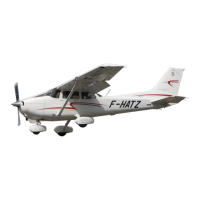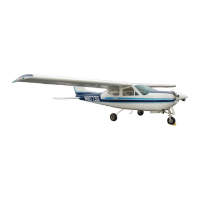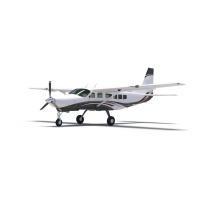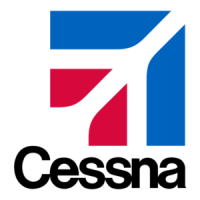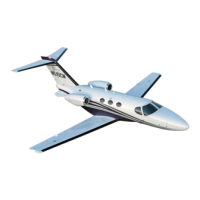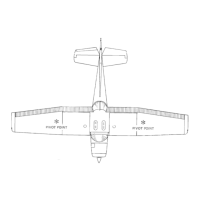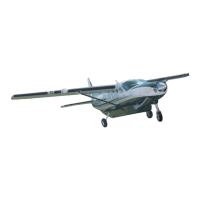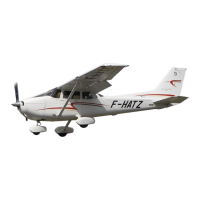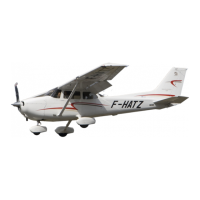Do you have a question about the Cessna C-182 and is the answer not in the manual?
Details about the engine, throttle, mixture control, carburetor heat, ignition, primer, and propeller pitch.
Information on the oil system, fuel system, and electrical system of the aircraft.
Explanation of flight controls, landing gear, brakes, instruments, and stall warning.
Details on cabin ventilators, lighting, and procedures for loading the aircraft.
Checklist items for pre-flight exterior inspection of the airplane.
Checklist for preparing the airplane before starting the engine.
Steps for starting the aircraft engine, including mixture and heat settings.
Procedure for warming up the engine and performing ground tests.
Checklist items to perform before initiating the take-off sequence.
Procedures for normal, minimum run, obstacle clearance, and crosswind take-offs.
Procedures for climbing the aircraft after take-off.
Guidelines for efficient cruising, including power settings and mixture leaning.
Procedure for descending the aircraft, managing power and temperature.
Checklist items to perform before commencing the landing sequence.
Procedures for normal and short field landings.
Checklist items to perform after the aircraft has landed.
Importance and procedure for clearing the propeller before starting the engine.
General guidelines for optimal engine operation, maintenance, and life.
Pre-flight inspection of engine and controls before starting.
Procedure for starting the engine, including primer and throttle usage.
Procedure for warming up the engine, including RPM limits and taxiing.
Guidelines for minimizing engine wear during take-off operations.
Engine operation guidelines for climbing at different altitudes and speeds.
Recommendations for cruising power settings, mixture leaning, and efficiency.
Procedure for operating the engine during descent, maintaining temperature.
Procedure for safely stopping the engine after landing.
Guidelines for safe and efficient taxiing, including speed and brake usage.
Details on authorized operations, including VFR and IFR capabilities.
Information on permitted maneuvers and prohibited aerobatics.
Certificated true indicated airspeed limits, including caution ranges.
Information on aircraft weight limits, balance conditions, and loading graphs.
Compilation of actual test data for airplane and engine performance.
Table for correcting indicated airspeeds to true indicated airspeeds.
Take-off data for various conditions, including weight, flaps, and temperature.
Climb data for different altitudes, speeds, and mixture settings.
Table detailing take-off distances and climb data under various conditions.
Table providing climb performance metrics at different altitudes and conditions.
Landing data including approach speeds, flap settings, and ground roll distances.
Essential requirements for maintaining aircraft performance, stamina, and dependability.
Proper procedures for maneuvering the airplane on the ground, including tow-bar use.
Procedure for securely tie-down the airplane to protect it from wind damage.
Recommendations for storing the airplane, lifting, jacking, and landing gear.
Maintenance of battery, plexiglas, and aluminum surfaces.
Care of engine compartment, upholstery, and propeller.
Procedure for rigging flaps, ailerons, rudder, elevators, and stabilizer trim.
Information on required inspections, service periods, and the 100-hour inspection.
Checklists for inspecting wings, empennage, surfaces, and nose gear.
Inspection of cabin, landing gear, brakes, radio, and instruments.
List of miscellaneous accessories and winterization equipment.
Details about the engine, throttle, mixture control, carburetor heat, ignition, primer, and propeller pitch.
Information on the oil system, fuel system, and electrical system of the aircraft.
Explanation of flight controls, landing gear, brakes, instruments, and stall warning.
Details on cabin ventilators, lighting, and procedures for loading the aircraft.
Checklist items for pre-flight exterior inspection of the airplane.
Checklist for preparing the airplane before starting the engine.
Steps for starting the aircraft engine, including mixture and heat settings.
Procedure for warming up the engine and performing ground tests.
Checklist items to perform before initiating the take-off sequence.
Procedures for normal, minimum run, obstacle clearance, and crosswind take-offs.
Procedures for climbing the aircraft after take-off.
Guidelines for efficient cruising, including power settings and mixture leaning.
Procedure for descending the aircraft, managing power and temperature.
Checklist items to perform before commencing the landing sequence.
Procedures for normal and short field landings.
Checklist items to perform after the aircraft has landed.
Importance and procedure for clearing the propeller before starting the engine.
General guidelines for optimal engine operation, maintenance, and life.
Pre-flight inspection of engine and controls before starting.
Procedure for starting the engine, including primer and throttle usage.
Procedure for warming up the engine, including RPM limits and taxiing.
Guidelines for minimizing engine wear during take-off operations.
Engine operation guidelines for climbing at different altitudes and speeds.
Recommendations for cruising power settings, mixture leaning, and efficiency.
Procedure for operating the engine during descent, maintaining temperature.
Procedure for safely stopping the engine after landing.
Guidelines for safe and efficient taxiing, including speed and brake usage.
Details on authorized operations, including VFR and IFR capabilities.
Information on permitted maneuvers and prohibited aerobatics.
Certificated true indicated airspeed limits, including caution ranges.
Information on aircraft weight limits, balance conditions, and loading graphs.
Compilation of actual test data for airplane and engine performance.
Table for correcting indicated airspeeds to true indicated airspeeds.
Take-off data for various conditions, including weight, flaps, and temperature.
Climb data for different altitudes, speeds, and mixture settings.
Table detailing take-off distances and climb data under various conditions.
Table providing climb performance metrics at different altitudes and conditions.
Landing data including approach speeds, flap settings, and ground roll distances.
Essential requirements for maintaining aircraft performance, stamina, and dependability.
Proper procedures for maneuvering the airplane on the ground, including tow-bar use.
Procedure for securely tie-down the airplane to protect it from wind damage.
Recommendations for storing the airplane, lifting, jacking, and landing gear.
Maintenance of battery, plexiglas, and aluminum surfaces.
Care of engine compartment, upholstery, and propeller.
Procedure for rigging flaps, ailerons, rudder, elevators, and stabilizer trim.
Information on required inspections, service periods, and the 100-hour inspection.
Checklists for inspecting wings, empennage, surfaces, and nose gear.
Inspection of cabin, landing gear, brakes, radio, and instruments.
List of miscellaneous accessories and winterization equipment.
